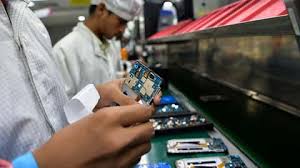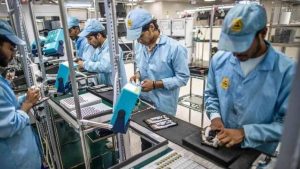Digital News Guru National Desk:
India’s electronics manufacturing sector has received a significant boost with the government’s approval of a Rs 22,919 crore (approximately $2.7 billion) scheme aimed at accelerating domestic production of electronic components. This move aligns with the nation’s broader ambition to become a global hub for electronics manufacturing while reducing dependence on imports. The new scheme is expected to attract Rs 59,350 crore in investments and generate over 91,600 direct jobs across the sector.
Why the Electronics Manufacturing Boost Matters?
The global electronics market is valued at over $2 trillion, and India, as one of the fastest-growing economies, is looking to capture a significant share of this industry. The demand for electronics in India is projected to surpass $400 billion by 2026, driven by rapid digitalization, smartphone penetration, and emerging technologies like 5G, artificial intelligence (AI), and electric vehicles (EVs).

Despite India’s progress in electronics manufacturing, the country still imports over 65% of its electronic components, particularly from China, Taiwan, and South Korea. The new government initiative is a strategic step toward reducing import dependence, strengthening the supply chain, and making India a key player in global electronics manufacturing.
Key Features of the Rs 22,919 Crore Scheme
The newly announced scheme aims to:
- Expand production of critical electronic components, including semiconductors, capacitors, resistors, diodes, and printed circuit boards (PCBs).
- Attract investments from global and domestic players in semiconductor and electronic component manufacturing.
- Create over 91,600 direct jobs and thousands of indirect jobs in supporting industries.
- Encourage research and development (R&D) to foster innovation in indigenous technology.
This initiative is part of India’s broader “Make in India” and “Digital India” campaigns, reinforcing its position as a self-reliant electronics powerhouse.
India’s Progress in Electronics Manufacturing
Over the past decade, India has witnessed remarkable growth in electronics production:
- The number of mobile phone manufacturing units has grown from just two in 2014 to over 300 in 2024, making India the second-largest mobile phone producer globally.
- Electronics exports have surged, reaching $29 billion in 2024, with India becoming a major supplier of smartphones, televisions, and electronic accessories.
- The government’s Production-Linked Incentive (PLI) scheme for smartphones has attracted global giants like Apple, Samsung, and Xiaomi, leading to the assembly of flagship models like the iPhone in India.
With the new $2.7 billion electronics manufacturing scheme, India aims to replicate this success in semiconductor and electronic component production.
How the Scheme Benefits the Indian Economy?
- Reduces Import Dependency:
- India currently imports $65 billion worth of electronic components annually.
- Domestic production of semiconductors and PCBs will significantly cut this import bill.
- Boosts Employment:
- Over 91,600 direct jobs will be created, along with thousands of indirect jobs in logistics, supply chain, and technical support.
- Enhances Global Competitiveness:
- India will emerge as an alternative manufacturing destination for global companies looking to diversify supply chains away from China.
- Supports Innovation & R&D:
- More investments in research will lead to advanced, homegrown technologies, helping India compete with leading electronic manufacturing nations like China, Taiwan, and South Korea.
Government Policies Supporting the Electronics Sector
In addition to the Rs 22,919 crore scheme, the government has implemented several policies to enhance India’s electronics ecosystem:
- Tax Incentives & Import Duty Reductions:
- Import duties on critical components used in EV batteries and mobile phones have been removed to support local production.
- Semiconductor Manufacturing Push:
- India has launched initiatives to set up semiconductor fabrication plants (fabs), such as the Tata Semiconductor Assembly & Test facility in Assam.
- Ease of Doing Business:
- Simplified policies, faster approvals, and land and infrastructure support for electronics manufacturers.
India’s Growing Semiconductor Industry
A major focus of India’s electronics manufacturing push is semiconductors, the “brain” of all modern electronic devices. The global semiconductor industry is valued at $500 billion, and India aims to become a key player in this domain.
Some key developments:
- Tata Semiconductor Assembly & Test Facility (Assam):
- India’s first indigenous semiconductor facility, with a Rs 27,000 crore investment.
- Expected to start production in late 2025.
- Partnerships with Global Chipmakers:
- Talks with TSMC (Taiwan) and Intel (USA) to set up chip fabrication plants in India.
- Vedanta-Foxconn JV planning a $19 billion semiconductor facility in Gujarat.
India’s semiconductor push aligns with its vision to become “Atmanirbhar” (self-reliant) in chip production and supply critical components for the global electronics industry.
Challenges and Future Prospects
Challenges:
- High Initial Investment:
- Setting up a semiconductor fab requires $5-10 billion, making it capital-intensive.
- Skilled Workforce Shortage:
- India needs more highly skilled engineers and technicians for semiconductor and advanced electronics manufacturing.
- Global Competition:
- Countries like China, Taiwan, and South Korea have a head start in semiconductor and electronics manufacturing.

Future Prospects:
Despite these challenges, India’s $2.7 billion electronics manufacturing boost is a game-changer. With strong government support, increasing private sector investment, and global partnerships, India is poised to become:
- A leading electronics manufacturing hub.
- A semiconductor powerhouse.
- A key supplier in the global tech supply chain.
Conclusion
India’s Rs 22,919 crore electronics manufacturing scheme is a bold step towards self-reliance and global competitiveness. By reducing import dependence, attracting investments, and creating jobs, India is strengthening its position as a major player in the global electronics industry. With the right policies, investments, and innovation, the country is well on its way to becoming a world leader in electronics and semiconductor manufacturing.
You May Also Read: Temasek Invests in Haldiram’s: What This $1 Billion Investment Means for India’s FMCG Sector









